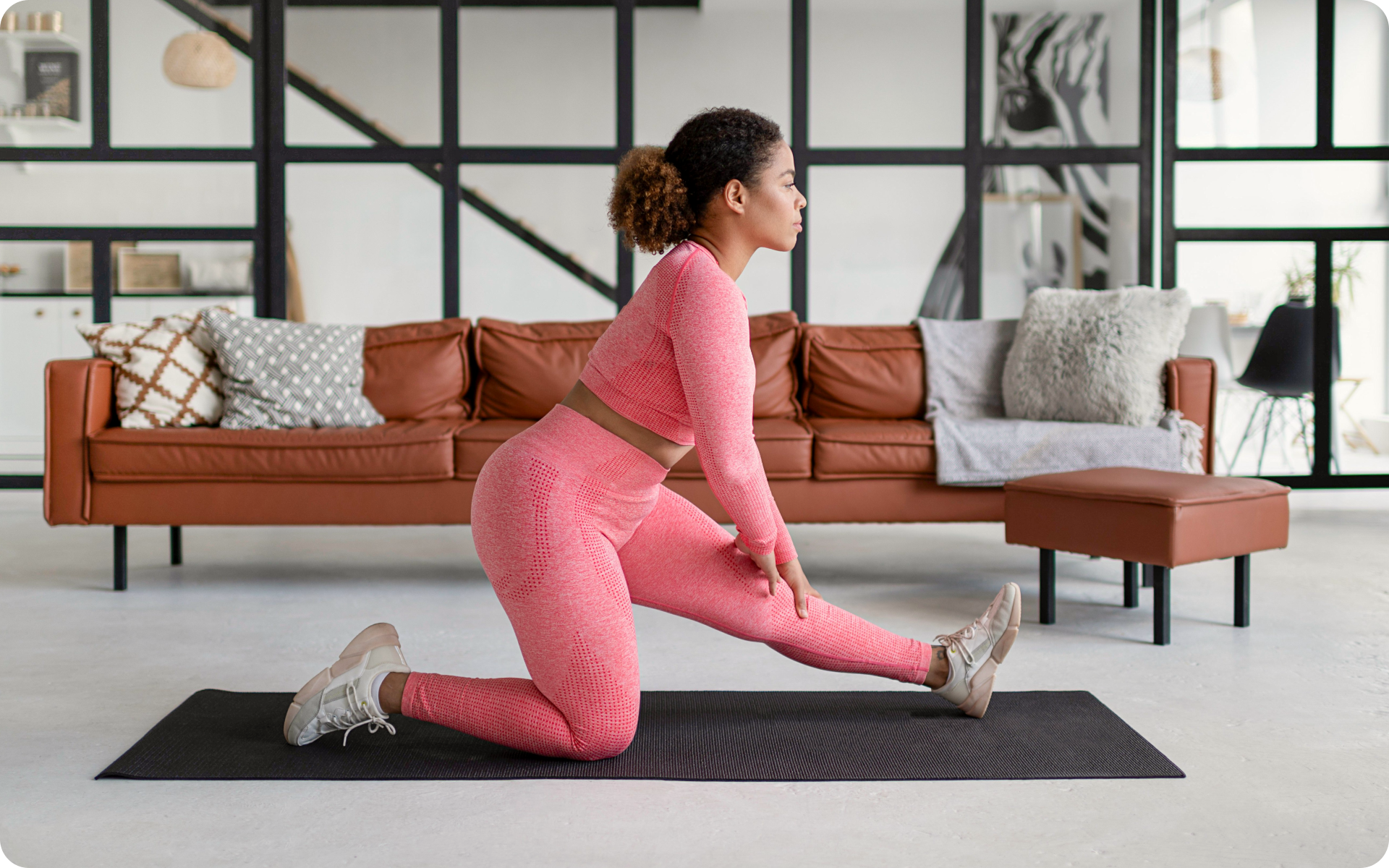Contrary to popular opinion, skipping rope is no longer just a game for kids. In fact, a growing number of adults are using a skipping rope as a way to stay fit and lose weight.
While a skipping rope can be a fun workout, one that brings back nostalgia from childhood, it can also help you burn calories, which makes it a great way to lose weight.
But can you really lose weight just by using a skipping rope for 2 weeks? The short answer is yes, but you shouldn’t expect to see drastic results.
In this article, we do a deep dive into what science says about this and how you can achieve long-term results. Read on to learn more about how a skipping rope can help you lose weight and how to create a safe and effective skipping routine for weight loss.
How a Skipping Rope Can Help You Lose Weight
A skipping rope is a great way to lose weight as it’s a high-intensity cardiovascular exercise that can help you burn calories.
However, it’s not just the calorie-burning benefits of skipping rope that make it great for weight loss. Skipping rope is also a weight-bearing exercise, meaning that it can help you build strong bones and muscles.
This is important because as you lose weight, you can also lose muscle mass, but if you do exercises such as those with a skipping rope that help you build muscle, you’ll be less likely to lose muscle mass as you lose weight if you combine it with a healthy diet that includes protein-rich foods.
Yanking yourself back in shape has never been so easy with our game-changing fitness app! Start transforming your life with BetterMe!
This will help you maintain a healthy body composition and prevent your metabolism from slowing down too much as you lose weight.
Other benefits of using a skipping rope as a cardiovascular exercise include:
- Improved heart health – It can help improve your heart health by increasing your heart rate and strengthening your heart muscles (10).
- Better endurance – It can help improve your lung capacity (3), strengthen your heart, and boost circulation. All these factors help increase your stamina and endurance.
Over time, you’ll notice that the more you jump rope, the less winded and tired you’ll get. Not only will you be able to skip for longer, it’ll also take you a while to get tired.
This translates into real life where you may realize that you can take longer walks, climb more flights of stairs, or even run better and longer without tiring out too quickly
- Improved mental health – Skipping rope is a great way to reduce stress and improve your mood.
- It’s fun – Unfortunately, being an adult does not come with many opportunities to simply do things for fun. A jumping rope can be an activity that is both good for your health and fun.
Research has proven that it’s easier to stick to an exercise routine if you’re doing something you enjoy. If you found skipping rope fun when younger, chances are you’ll enjoy it now that you’re older too. This can help you stick to the routine and lose some weight.
Is Skipping Rope a Full-Body Workout?
Yes, skipping rope is most certainly a full-body workout.
When jumping, your calves, thighs, and feet are involved in the movement, meaning that the entire lower body is involved in this exercise.
Your upper body is also involved in this workout. The action of flinging the rope up and down engages the muscles in your arms, shoulders, and upper back.
Skipping rope also engages the abs, but not directly. While jumping, the core muscles must remain engaged in order to stabilize you and prevent you from falling over.
How Much Weight Can I Lose in a Week with a Skipping Rope?
Skipping rope is not a magic bullet for weight loss and you really shouldn’t expect to lose a lot of weight in a week by jumping rope.
In fact, it’s realistic to expect to lose 1-2 pounds per week by adding a skipping rope (or any other new exercise) to your routine. This may not seem like much, but it adds up, and it’s a healthy, sustainable rate of weight loss.
As stated above, jumping rope is not a magical pill. It will not work for your weight loss goals if you don’t also make positive changes to your diet. Skipping rope – or any other workout – is a great way to burn calories and lose weight, but it’ll not help you much if you still eat too many calories.
To lose weight at a healthy sustainable rate, you should aim to create a calorie deficit of 500-1,000 calories per day (8). This can be done by reducing your food intake, increasing your activity level, or ideally, a combination of both.
Regarding your food intake, these tips can help you create a healthy, balanced diet that will help you lose weight:
- Choose nutrient-rich foods – Foods that are high in nutrients and low in calories, such as fruits, vegetables, lean proteins, and whole grains.
- Limit processed foods – Cut back on processed foods, which are often high in calories, sugar, and unhealthy fats.
- Avoid sugary drinks – Ditch sugary drinks such as soda, juice, and sports drinks. They may be delicious, but all they do is add a lot of empty calories to your diet.
- Eat mindfully – Pay attention to your hunger cues and only eat when you’re truly hungry. This will help you avoid mindless eating and overeating which will make you go over your recommended calorie deficit.
- Practice portion control – This goes hand-in-hand with mindful eating. When you eat, pay attention to your portions and don’t overeat.
Some people find weighing and measuring their food to be helpful, while for others, simpler methods such as using hand sizes (e.g., a palm-sized portion of protein) can work well.
Read more: The Ice Hack to Lose Weight: Is There Science to Support the Claims?
Is Skipping Rope Better Than Running?
It depends who you ask.
As they’re both cardio workouts, the benefits of running and jumping rope seem to overlap, so whether skipping rope is better than running and vice versa is largely dependent on the individual.
Our advice is to try both exercises for about 2-4 weeks and choose the one you feel works best for you. As stated above, the workout you enjoy the most is the one you’re most likely to stick with.
Another point to consider is how long you can do each exercise for. The better cardio workout for you is the one you can perform for a longer period of time and that elevates your heart rate higher during that sustained effort. This will help you burn more calories while also strengthening the lungs and heart.
It’s important to remember that some people are better runners, while others excel at jumping rope. Find what works best for you and go with that.
How to Create a Skipping Rope Routine for Weight Loss
Having a proper routine is the most important step to success in every endeavor. Choosing the right tools to help you reach your goal is also essential.
With this in mind, be sure to invest in a good skipping rope. The best jump rope for you will be one that’s the right size for your height, has comfortable handles, and a smooth rope.
If you’re looking to use skipping rope as a way to lose weight, here are a few things to keep in mind to create a safe and effective skipping routine.
Warm Up
Many people overlook the importance of warming up before skipping rope, but it’s essential to prepare your body for the high-impact nature of the exercise. A good warm-up will help increase your heart rate and loosen your muscles, which will reduce your risk of injury (2).
To warm up for skipping rope, start with some light cardio exercises such as walking or jogging on the spot for a few minutes. Then, do some dynamic stretches such as leg swings and arm circles to further loosen your muscles.
Once you feel warm, start skipping rope at a slow pace for one minute before increasing your speed.
Use Proper Form
As with all exercises, it’s important to maintain proper form when skipping rope to reduce your risk of injury. When you first start out, it can be helpful to practice without a rope to get a feel for the movement. Once you have the hang of it, you can start using a rope.
When skipping with a rope:
- Hold the handles in your hands with the rope behind you and stand with your feet together.
- Swing the rope over your head and jump as it passes under your feet.
- Land on both feet at the same time, making sure to keep your knees slightly bent to absorb the impact.
- As you become more comfortable with the movement, you can start to increase your speed.
- Start slow and progress gradually.
If you’re new to skipping rope, start by jumping for 30 seconds and resting for 30 seconds in between sets. As you become more comfortable, you can increase the length of your skipping intervals and reduce the amount of time you rest in between.
If you’re looking to lose weight, you’ll need a skipping rope workout that consists of two to three sets of one-minute intervals with 30 seconds of rest in between. As you get fitter, you can increase the number of sets and the length of your intervals.
Cool Down
Just as it’s important to warm up before you skip with a rope, it’s important to cool down after your skipping workout. This will help your heart rate and breathing return to normal and prevent you from feeling dizzy or lightheaded.
To cool down, start by skipping rope at a slower pace for one minute. Then, do some static stretches such as quadriceps stretches and hamstring curls. Finally, finish with some light cardio such as walking on the spot to bring your heart rate and breathing back to normal.
If you wish to cinch your waist, tone up your bat wings, blast away the muffin top – our fitness app was created to cater to all your needs! BetterMe won’t give excess weight a chance!
7-Day Jump Rope Challenge Sample Routine
A 7-day challenge is a great way to kickstart your journey to losing weight with a skipping rope. The following routine is a sample of what your week could look like:
Day 1
- Warm-up: 5 minutes of light cardio that includes dynamic movements and stretches
- Workout: Skip for 20 seconds at a moderate pace, rest for 20 seconds, repeat for 10 minutes
- Cool-down: 5 minutes of light cardio and static stretches
Day 2
- Warm-up: 5 minutes of light cardio that includes dynamic movements and stretches
- Workout: Skip for 20 seconds at a moderate pace, rest for 20 seconds, repeat for 10 minutes
- Cool-down: 5 minutes of light cardio and static stretches
Day 3
- Warm-up: 5 minutes of light cardio that includes dynamic movements and stretches
- Workout: Skip for 30 seconds at a moderate pace, rest for 20 seconds, repeat for 10 minutes
- Cool-down: 5 minutes of light cardio and static stretches
Day 4
- Warm-up: 5 minutes of light cardio that includes dynamic movements and stretches
- Workout: Skip for 30 seconds at a moderate pace, rest for 20 seconds, repeat for 10 minutes
- Cool-down: 5 minutes of light cardio and static stretches
Day 5
- Warm-up: 5 minutes of light cardio that includes dynamic movements and stretches
- Workout: Skip for 40 seconds at a moderate pace, rest for 20 seconds, repeat for 10 minutes
- Cool-down: 5 minutes of light cardio and static stretches
Day 6
- Warm-up: 5 minutes of light cardio that includes dynamic movements and stretches
- Workout: Skip for 30 seconds at a fast pace, rest for 30 seconds, repeat for 10 minutes
- Cool-down: 5 minutes of light cardio and static stretches
Day 7
- Warm-up: 5 minutes of light cardio that includes dynamic movements and stretches
- Workout: Skip for 30 seconds at a fast pace, rest for 30 seconds, repeat for 10 minutes
- Cool-down: 5 minutes of light cardio and static stretches
What Are the Disadvantages of Skipping Rope?
Yes, skipping rope has incredible benefits, but it also has some potential drawbacks. Some of these include:
- It can be tough on the knees – While skipping rope is said to be better than running in terms of causing knee pain, you should still be careful (9, 6).
As skipping rope is a high-impact workout, it can cause damage to your knees or feet, particularly if your shoes don’t have enough cushioning and if you’re jumping on the wrong kind of surface e.g. concrete (4).
- It takes a while to learn – Jumping rope seems easy enough but in truth, it requires quite a bit of coordination. Lack of coordination can lead to tripping. However, this isn’t too hard to learn and can be overcome with patience and consistency.
- It can be too taxing on the cardiovascular system – While cardio is known to improve the cardiovascular system, it may be too much for people who have existing cardiovascular problems. If you have heart or lung problems, please speak to your doctor before you opt to start skipping to lose weight.
- Space – Skipping rope doesn’t require a lot of space, but if you live in an apartment, you may receive noise complaints from your downstairs neighbors.
Read more: Boxing Calories Burned: Lose Weight by Punching
FAQs
Is 400 skips a day good?
Yes, 400 skips a day is good for beginners. However, for intermediate or advanced exercisers, 400 skips may be too little, although it can work as a good warm-up before getting into more intense/heavier workouts.
How many skips a day to lose belly fat?
Belly fat, which is also known as visceral fat, is made up of white fat – one of the many types of body fat that we all have in our bodies (1). While white fat isn’t necessarily bad, too much of it can lead to obesity and other health problems.
While there isn’t a specific number of skips you can jump in a day to help you lose belly fat, starting with jumping rope for 30 minutes a day will go a long way to helping you achieve your goal.
How many skips a day to lose 1 kg in a week?
All bodies are made different so there is no ‘one size fits all’ answer to this question. Once again, start by skipping with a rope for 30 minutes a day for a week and start making changes to your diet. This will most likely help you lose up to 1 kilogram a week.
What happens if I do 500 skips a day?
The most obvious result will be weight loss. Some less noticeable changes may be improved lung and heart health, in addition to improved endurance and stamina. Over time, you may also notice improvements in your self-confidence.
Does planking burn fat?
Yes, it does. As with any other exercise, planking burns calories, which can be a factor in weight loss. It is also a fantastic exercise for improved core strength.
What causes belly fat in females?
Excessive belly fat in women can be caused by multiple factors, including (5, 11):
- Increased stress levels
- Poor sleep – less than 7 to 9 hours of sleep a night
- Poor diet and eating at a caloric surplus
- A sedentary lifestyle
- Genetics – some people are more likely to store extra fat in their bellies than others
- Menopause due to dropping estrogen levels
- Alcohol use
The Bottom Line
Skipping with a rope is a great exercise for weight loss as it’s a high-intensity cardiovascular workout that can help you burn calories. It’s also a weight-bearing exercise, meaning that it can help you build strong bones and muscles.
To get the most out of skipping for weight loss, make sure you warm up before your workout, cool down afterward, and use proper form throughout. Start with shorter intervals and progress gradually as you become more comfortable with the exercise.
DISCLAIMER:
This article is intended for general informational purposes only and does not serve to address individual circumstances. It is not a substitute for professional advice or help and should not be relied on for making any kind of decision-making. Any action taken as a direct or indirect result of the information in this article is entirely at your own risk and is your sole responsibility.
BetterMe, its content staff, and its medical advisors accept no responsibility for inaccuracies, errors, misstatements, inconsistencies, or omissions and specifically disclaim any liability, loss or risk, personal, professional or otherwise, which may be incurred as a consequence, directly or indirectly, of the use and/or application of any content.
You should always seek the advice of your physician or other qualified health provider with any questions you may have regarding a medical condition or your specific situation. Never disregard professional medical advice or delay seeking it because of BetterMe content. If you suspect or think you may have a medical emergency, call your doctor.
SOURCES
- Body Fat (2022, hsph.harvard.edu)
- Does warming up prevent injury in sport? The evidence from randomised controlled trials?(2006, pubmed.gov)
- Effects of Jumping Exercise on Muscular Power in Older Adults: A Meta-Analysis (2018, pubmed.gov)
- Effects of Physical Activity in Knee and Hip Osteoarthritis: A Systematic Umbrella Review (2019, ncbi.nlm.nih.gov)
- Lifestyle Factors and 5-Year Abdominal Fat Accumulation in a Minority Cohort: The IRAS Family Study (2012, ncbi.nlm.nih.gov)
- Lower extremity joint loading during Bounce rope skip in comparison to run and walk (2021, ncbi.nlm.nih.gov)
- Preserving Healthy Muscle during Weight Loss (2017, nih.gov)
- Skipping has lower knee joint contact forces and higher metabolic cost compared to running (2019, pubmed.ncbi.nlm.nih.gov)
- The effects of dance music jump rope exercise on pulmonary function and body mass index after music jump rope exercise in overweight adults in 20’s (2017, nih.gov)
- Why Do Women Gain Belly Fat in Midlife? (2022, nytimes.com)










